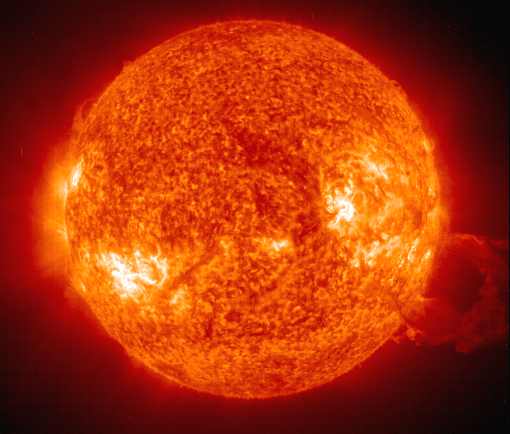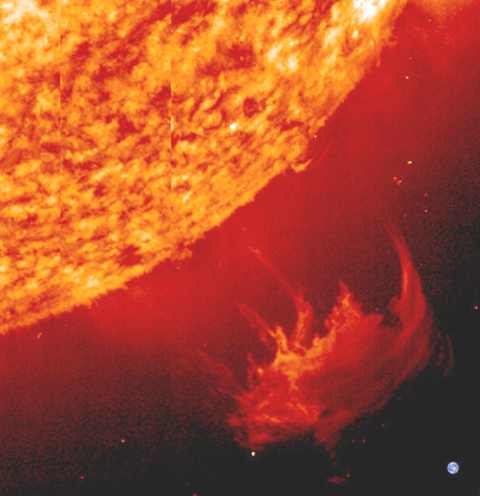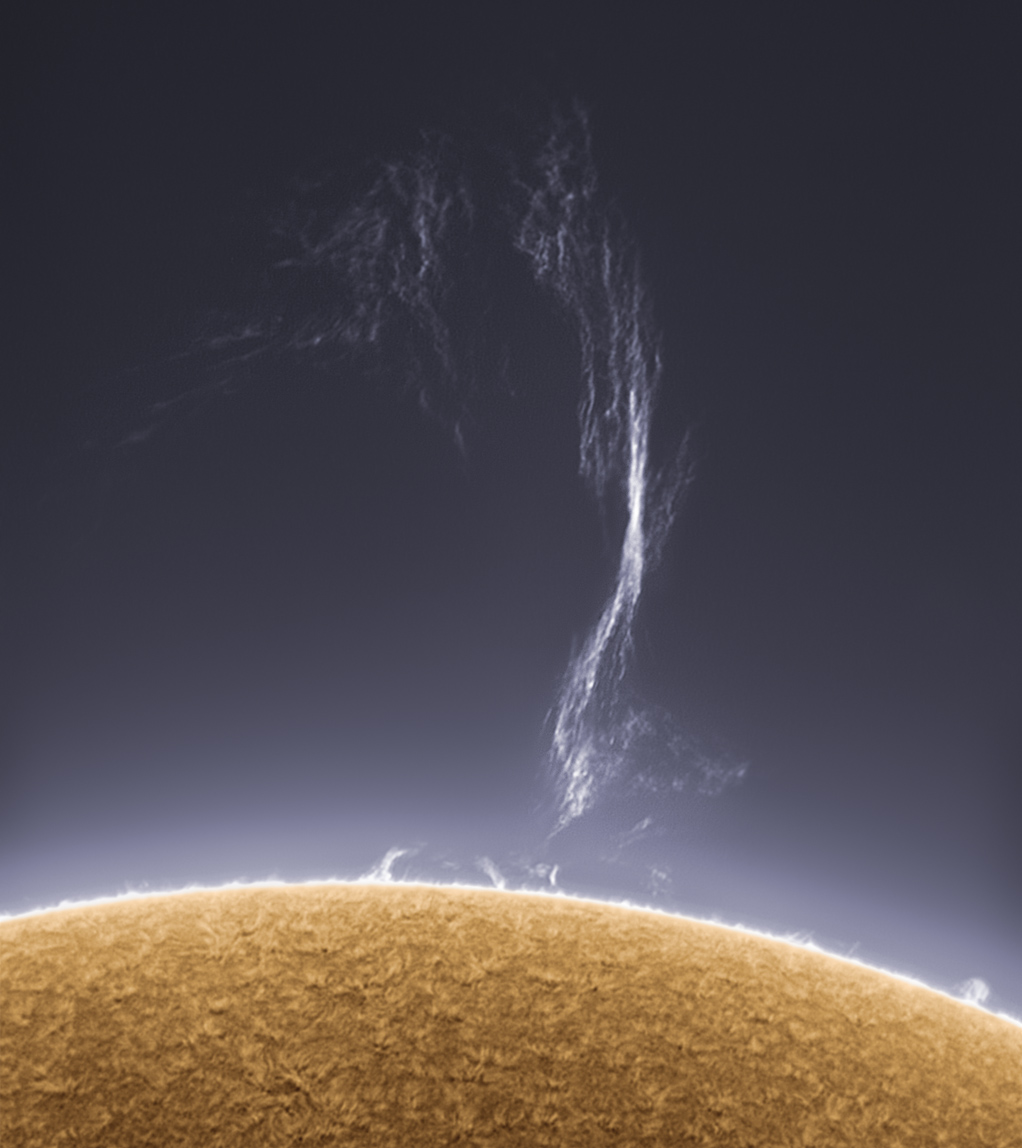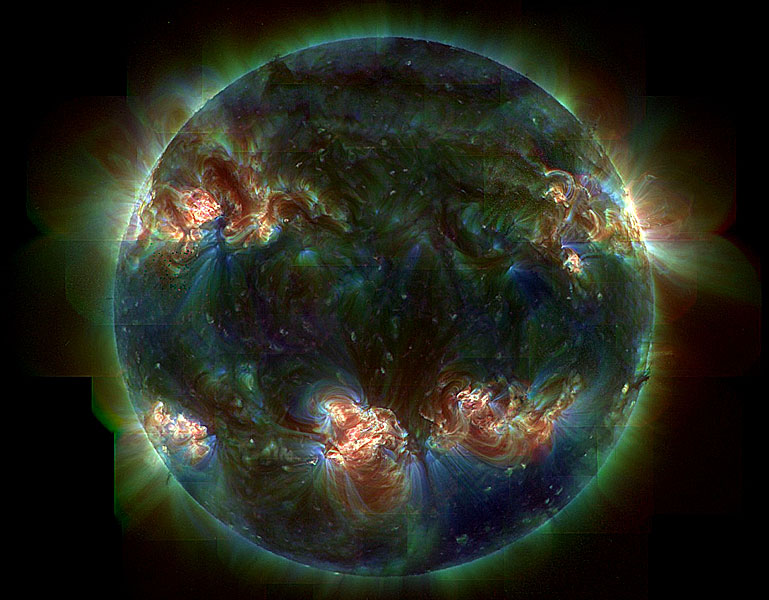Unreasonable star colors in astronomical artwork
Posted: Mon Jul 11, 2011 6:50 am
I have complained bitterly about the colors of stars in astronomical pictures, not least the color of our Sun in ultraviolet images. These images typically look like this:
The color here is a (to me) very frustrating deep, deep orange. But Chris has pointed out to me that since ultraviolet light is invisible in any case, it has to be shown in false or mapped color anyway, and then it doesn't matter what specific hue is used to show it in images. I reluctantly agree, although I still strongly dislike the deep, deep orange color.
Recently a Swedish-language ambitious magazine on astronomy was on sale in Swedish newspaper and magazine outlets. This magazine described, among other things, stellar evolution. This description started somewhat like this:
There are three kinds of stars. The first kind is the low-mass stars: The second kind is the intermediate-mass stars: The third kind is the high-mass stars: [/i]
I'm not kidding you, this magazine used exactly the same illustration of a star to represent low-mass, intermediate-mass and high-mass stars, and all of them were exactly the same orange color! Now perhaps you object that perhaps the magazine was referring to later stages of the intermediate and high-mass stars, when indeed they will be orange (though hardly ever as orange as they look in the pictures above). But in actuality, the three identical orange pictures supposedly showed the appearance of the stars when they were on the main sequence.
Is there any reason to illustrate low-mass, intermediate-mass and high-mass main sequence stars with the same deeply orange picture of a star? Absolutely not, in my opinion. Is there any excuse for doing it? Absolutely not, in my opinion. (Oh, and by the way, since the same orange picture of a star was shown to describe low-mass, intermediate-mass and high-mass stars, not only were the stars shown to be the same color, they were also shown to be the same size!)
Well, I'm not suggesting that whoever put that Swedish-language magazine together knew what they were doing. Fortunately, this magazine is not likely to circulate its lies about stars far beyond the borders of Sweden and the small fraction of the total population of 9 million Swedes who are astronomy fans.
But when it comes to the Hubble Telescope, those who will see and believe in the pictures are just so much more numerous. Which is exactly why it is far more serious when the color of Hubble images are obviously wrong.
But before I show you what I mean, let's return to one of those "conventional truths" about stars that get their colors so extremely wrong. I said before that I reluctantly agree with Chris that it may be all right to show the ultraviolet light of the Sun as orange, since the ultraviolet light is invisible in any case and must be shown as false or mapped color anyway.
But I seriously think that it should be made clear that the orange color that we see so often in pictures of the Sun is mapped color!! Not true color!!!
Okay. Now take a look at a picture which mixes the mapped orange color of the Sun with the more or less true colors of the Earth: Here you can see the very orange mapped color disk of the Sun, plus a large red solar flare, plus a more or less true RGB color image of the Earth at lower left.
This picture mixes mapped color and true RGB color, strengthening the impression that the Sun is "really" orange.
Okay, now for the latest Hubble image, an artist's impression of a distant sun and its planet:
Hmmm. The sun looks extremely yellow, while the planet looks sort of aqua-colored and brown. The planet looks like a mixture of Jupiter and Uranus. That could be the true color of an alien planet.
But what about the color of that alien sun?
It is very yellow. Okay, if the star is very low-mass, it could be as yellow as that for real. The same could be true if the star in an evolved giant. The color of Arcturus, a K2 giant, looked as yellow as that when I observed it once through a telescope. (But on other occasions Arcturus has looked much paler to me.)
Ah. But hear now what the caption says about the star and the planet:
Right. And wrong. Yes, yellow is a bluer color than orange. But no, the Sun is not orange!!!
If that star is hotter than the Sun, the artist should at the very least have shown it as white. Better yet, he(?) should have shown it as a pale blue color.
And if people don't understand that a bright white round object could be a sun, then that just goes to show how much people have been lied to about the color of stars.
The Sun?
Ann
The color here is a (to me) very frustrating deep, deep orange. But Chris has pointed out to me that since ultraviolet light is invisible in any case, it has to be shown in false or mapped color anyway, and then it doesn't matter what specific hue is used to show it in images. I reluctantly agree, although I still strongly dislike the deep, deep orange color.
Recently a Swedish-language ambitious magazine on astronomy was on sale in Swedish newspaper and magazine outlets. This magazine described, among other things, stellar evolution. This description started somewhat like this:
There are three kinds of stars. The first kind is the low-mass stars: The second kind is the intermediate-mass stars: The third kind is the high-mass stars: [/i]
I'm not kidding you, this magazine used exactly the same illustration of a star to represent low-mass, intermediate-mass and high-mass stars, and all of them were exactly the same orange color! Now perhaps you object that perhaps the magazine was referring to later stages of the intermediate and high-mass stars, when indeed they will be orange (though hardly ever as orange as they look in the pictures above). But in actuality, the three identical orange pictures supposedly showed the appearance of the stars when they were on the main sequence.
Is there any reason to illustrate low-mass, intermediate-mass and high-mass main sequence stars with the same deeply orange picture of a star? Absolutely not, in my opinion. Is there any excuse for doing it? Absolutely not, in my opinion. (Oh, and by the way, since the same orange picture of a star was shown to describe low-mass, intermediate-mass and high-mass stars, not only were the stars shown to be the same color, they were also shown to be the same size!)
Well, I'm not suggesting that whoever put that Swedish-language magazine together knew what they were doing. Fortunately, this magazine is not likely to circulate its lies about stars far beyond the borders of Sweden and the small fraction of the total population of 9 million Swedes who are astronomy fans.
But when it comes to the Hubble Telescope, those who will see and believe in the pictures are just so much more numerous. Which is exactly why it is far more serious when the color of Hubble images are obviously wrong.
But before I show you what I mean, let's return to one of those "conventional truths" about stars that get their colors so extremely wrong. I said before that I reluctantly agree with Chris that it may be all right to show the ultraviolet light of the Sun as orange, since the ultraviolet light is invisible in any case and must be shown as false or mapped color anyway.
But I seriously think that it should be made clear that the orange color that we see so often in pictures of the Sun is mapped color!! Not true color!!!
Okay. Now take a look at a picture which mixes the mapped orange color of the Sun with the more or less true colors of the Earth: Here you can see the very orange mapped color disk of the Sun, plus a large red solar flare, plus a more or less true RGB color image of the Earth at lower left.
This picture mixes mapped color and true RGB color, strengthening the impression that the Sun is "really" orange.
Okay, now for the latest Hubble image, an artist's impression of a distant sun and its planet:
Hmmm. The sun looks extremely yellow, while the planet looks sort of aqua-colored and brown. The planet looks like a mixture of Jupiter and Uranus. That could be the true color of an alien planet.
But what about the color of that alien sun?
It is very yellow. Okay, if the star is very low-mass, it could be as yellow as that for real. The same could be true if the star in an evolved giant. The color of Arcturus, a K2 giant, looked as yellow as that when I observed it once through a telescope. (But on other occasions Arcturus has looked much paler to me.)
Ah. But hear now what the caption says about the star and the planet:
So the star is hotter than the Sun. Then its color will necessarily be bluer than the color of the Sun. All right, but since the Sun is orange, then it makes good sense that that other star is yellow, right? Because yellow is a bluer color than orange, right?July 5, 2011: NASA's Hubble Space Telescope crossed another milestone in its 21-year space odyssey of exploration and discovery. On Monday, July 4, the Earth-orbiting observatory logged its one millionth science observation during a search for water in an exoplanet's atmosphere 1,000 light-years away. Although Hubble is best known for its stunning imagery of the cosmos, the millionth exposure is a spectroscopic measurement, where light is divided into its component colors. These color patterns can reveal the chemical composition of cosmic sources. This is an artist's concept of Hubble's millionth exposure, the extrasolar planet HAT-P-7b. It is a gas planet larger than Jupiter orbiting a star hotter than our Sun. HAT-P-7b, also known as Kepler 2b, has been studied by NASA's planet-hunting Kepler observatory after it was discovered by ground-based observations.
Right. And wrong. Yes, yellow is a bluer color than orange. But no, the Sun is not orange!!!
If that star is hotter than the Sun, the artist should at the very least have shown it as white. Better yet, he(?) should have shown it as a pale blue color.
And if people don't understand that a bright white round object could be a sun, then that just goes to show how much people have been lied to about the color of stars.
The Sun?
Ann










